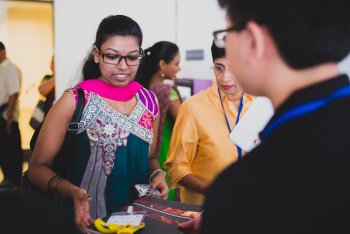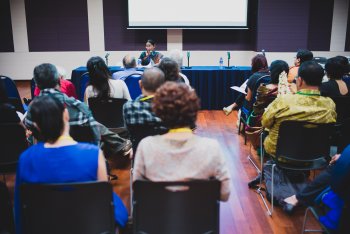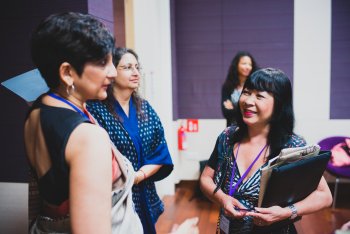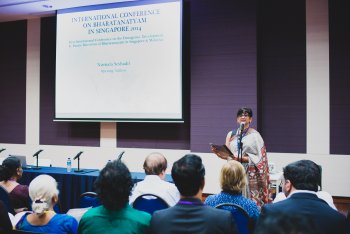
|   |

|   |
International Conference on Bharatanatyam in Singapore - Dr. Maha Sripathy e-mail: mahasripathy@gmail.com Photos: Style Revisited December 24, 2014 What is the future of Bharatanatyam in an increasingly diverse and borderless world? Is its continued existence dependant on the preservation of its purity- if such purity can be attested to? Or will its very future evolve out of an inevitable mutation of historical experiences rooted in the politics of survival as the form is transported in time and place? To answer these salient questions following months of discussion, consultation and meticulous planning, the First International Conference on Bharatanatyam took off to a promising start on Dec 6, 2014 under the funded patronage of the National Arts Council and the support of Nrityalaya Aesthetics Society and NUS Centre for the Arts. Organized by N Dance & Yoga (A Space for Research & Experimentation in Dance & Somatic Practices), conference curator Nirmala Seshadri in her welcome address, set the tone for the two-day deliberation on the emergence, development and future directions of a dance form that has traversed both time and place. Nirmala, who is N Dance & Yoga’s Artistic Director, asked for critical dialogue of the roots and the increasing socio-cultural situatedness of the form, which has brought to the forefront issues surrounding the complexities of present-day practice and performance and raised interesting trajectories for future transitions. Over the next two days, practitioners and scholars took up her challenge and converged to trace the roots of Bharatanatyam and its current engagement fuelling exciting discussion on cultural heritage, policies and transformational practices. 

The conference began with Santha Bhaskar’s keynote address which provided an overview of the origins and development of the Bharatanatyam scene in Singapore, capturing the personalities and choreographies that dotted the landscape as the form embedded itself first into the Singapore and Malaysian Indian psyche and then in the official national space. Her practitioner’s views were further surveyed and developed by Ann David in her focused discussion of pioneering Singaporean Bharatanatyam dancer, Rathi Karthigesu, who pursued the dance against much community disapproval, only to gain international acclaim as she performed on the world stage. In fact, as Ann rightfully points out in her paper, Rathi made Bharatanatyam the defining aspect of the well accomplished and refined young Indian lass. She in many ways turned a form, which Davesh Soneji in his paper ‘Mapping representations of Tamil Devadasi dance in the Malay Peninsula’ describes as being performed by courtesans, into a very respectable and worthy pursuit for young Tamil girls. Soneji traced the development of the form through the historical, socio-cultural and economic trajectories of the Indians in Malaya and shows the evolution of Bharatanatyam to its present position. This survey shows very clearly how the form was perceived and used - a documentation that captures both the climate of the times and the transformation process it underwent. Several other papers by Gauri Krishnan, Aparna Nambiar, Lavanya Ramesh, Siri Rama and Wong Chee Meng provided ample background on the rootedness of this form and its development on the current stage and space, to fill the historical gap for the non-Bharatanatyam delegates at the conference. The highlight of these historical overviews was Hari Krishnan’s paper ‘Celluloid Classicism...’ which connected the current practice of Bharatanatyam to the history of South Indian cinema - a link that has been overlooked by many a researcher here. Hari showed very clearly the positioning of particular groups of women in Bharatanatyam before and after Bharatanatyam gained a respectable entry into South Indian Tamil cinema and the cultural intertwining of the form and the medium, which angled the development of the form here. Bharatanatyam as cultured art came to us through its presentation in Tamil cinema. It will not be wrong to say that it was Tamil cinema that exonerated Bharatanatyam from its undignified position and exalted it to a deified, almost highbrow form of pleasurable entertainment, to be pursued by society’s cultured. Today, as Nidya Shanthini Manokara observes in her paper ‘Performing Bharatanatyam: Cultural authority and multiculturalism in the little red dot,’ despite the classification of Bharatanatyam as an art form practiced by Tamil Singaporeans, it has become "integrated into the local performance context" through its inclusion in "spectacular events like the National Day Parades" and the Singapore Youth Festival (SYF). She raises significant questions about the impact on both the "aesthetics and sociology of the form” consequent upon the "localization / appropriation" of Bharatanatyam in multicultural Singapore. This sociological perspective is echoed by Yoshiaki Takemura who suggested that Singapore will have a major role in the direction Bharatanatyam will take as a performance art and how it is positioned in the 21st century. The conference also showcased a good array of practitioners and tertiary educators, who shared their approach to the practice and performance of the form. Caren Carino’s inclusion of Bharatanatyam in the dance curriculum at the Nanyang Academy of Fine Arts, the multi-ethnic development of Bharatanatyam in Malaysia by Joseph Gonzales, Kavitha Krishnan’s lecture-demonstration on the deconstruction and reconstruction of the Bharatanatyam form and the use of Asian contemporary expressions to connect with tradition, Aravinth Kumarasamy’s video presentation of moving Bharatanatyam into the realm of group choreography and the challenges in making this transition and Premalatha Thiagarajan’s focus on the emergence of the male Bharatanatyam dancers in Malaysia, gave the delegates much food for thought. Kiran Kumar had an interesting take on Bharatanatyam as an artist. Introducing dance-new media relationship, he took the delegates on a surreal artistic experience of dance not as culturally framed ritualistic practice, but as imaging to create movement with digital technology - an interesting and emergent field that will map Bharatanatyam differently for future generations. Indeed the delegates’ questions and vibrant discussions following these papers bear excellent testimony to the complexities of being a Bharatanatyam practitioner in this time and age and the energies the ideas generated. The conference’s greatest claim must be its careful framing to move beyond the history and practice of Bharatanatyam - necessary as these are for the holistic understanding of the way forward - to its global situatedness amidst socio-cultural fluidity. In this aspect, this first conference on Bharatanatyam must take credit for confronting the issues that are very often overlooked in the practice and performance of the dance form. Issues of gender and identity are big ticket items in the 21st century and Bharatanatyam cannot devolve itself from them. Urmimala Sarkar Munsi’s keynote address, ‘Yet another gendered reading of Bharatanatyam: constructions within a trans-generational / trans-geographical/ trans-cultural visibility’ delved into the different types of identities the Bharatanatyam form engenders in its very practice and performance. She puts in perspective the situatedness of the form and its material context and ritual components in relation to the performer and the audience. Her assertion that Bharatanatyam be a platform, a medium for fighting marginalization, raising society’s consciousness to highlight irregularities and making sure those voices are heard is a timely one in directing practitioners to paying attention to the representations they endorse and propagate - for in this lies the societal configurations of the future, in both the socio-cultural and moral sense. She critically questions Bharatanatyam’s role as an accepted medium for affirming embodied knowledge of gender, sexuality, class, caste and community identities. Can the practice of Bharatanatyam move beyond the traditional representations of these received understandings to reflect the changing perspectives and lived experiences of people 
 Nirmala Seshadri As if to answer this scholarly challenge came Sadanand Menon’s paper on ‘Letting the body move: Chandralekha’s demystification of cultural pasts.’ Sadanand took the delegates through an engaging journey of Chandralekha’s deconstruction of the form to focus the dance on the body minus the elaborate costumes and jewellery and cosmeticized embellishment. His informed and studied analysis of Chandralekha showed us exactly how the “ideologically loaded cultural pasts” must necessarily make way for new presentations which encompass the lived realities of this century. And this is precisely what Nirmala Seshadri’s thought provoking paper ‘Then and Now/ This and That: A continuing conversation’ did to bring the conference full circle. Through the lens of the body and working through the constructs of phenomenology and hybridity, she discussed the dialogic construction of identity through cross cultural collaborations. Her practice based paper shared her experience of transforming Bharatanatyam in the Singapore context and the contestations it generated. Indeed this cultural confluence will engender a hybridized Bharatanatyam and therein seems to lie its future. These 3 papers very pointedly established the direction Bharatanatyam must take to stay relevant - if dance is body made poetic, representing the socio-cultural, political and historical intersections across borders, then it is essential that practitioners and audiences reflect and review what is made visible in and through dance. All in all, this first conference on Bharatanatyam has set the stage for an engaging and energizing dialogue that will chart the future directions of Bharatanatyam in Singapore. If anything, the myriad of questions and exciting discussions that followed the paper presentations, the roundtable discussions and the enthusiastic coffee break exchanges and lunch time deliberations (all compressed within two days) point to new synergies for Bharatanatyam in Singapore and Malaysia. The numerous requests for follow-up seminars and dialogues sum up the engagement the conference has very commendably generated to reclaim Bharatanatyam as a human experience, reflecting the times we are living in and to carry this discourse forward. This would of necessity require a serious rethink of audience engagement - a moot point delegates kept returning to throughout the conference. I am sure having curated the first successful conference on Bharatanatyam, which brought together for the first time practitioners, scholars and dance enthusiasts to sit together and enjoy engaging discourse, N Dance & Yoga is ready to launch its next step into taking this dialogue further. We can only wait with baited breath! Dr. Maha Sripathy’s passion is teaching. Believing in empowerment through education, she shares her knowledge and expertise with Early Childhood practitioners and pre-service and in-service teachers in Singapore, Sri Lanka and Australia. She also works with graduate and post-graduate students in the areas of cross-cultural discourse and critical cultural literacies. Her interest in the arts has given her commitment to education an added dimension. She is currently a consultant in curriculum development and teacher education in third world countries. |